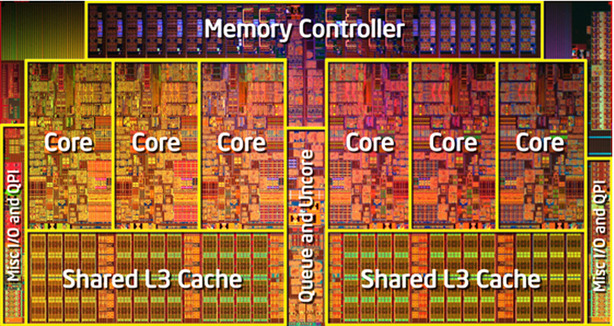What makes Gulftown tick
Intel has managed to squeeze six cores into the same LGA1366 packaging as the other models of the Core i7 series by making the i7-980X from 32nm rather than 45nm transistors.Smaller transistors are crucial, as they're more power-efficient due to reduced leakage; they also switch faster and can therefore be clocked higher. Plus, more of these can be squeezed onto a wafer, reducing the size of each CPU die and lowering the cost of manufacturing for each CPU.
The i7-980X isn't the first 32nm CPU - that honour goes to the Clarkdale dual-core Core i3 and Core i5s launched in January.
However, the i7-980X has been in development for far longer, as we've played with three different steppings of pre-production prototypes over the past five months.

Gulftown has a very similar physical layout to Bloomfield to retain socket compatibility
 This is far earlier than we'd usually be able to test a CPU before its public release, and shows just how focused Intel was on perfecting the i7-980X. For example, despite having two more cores, the i7-980X barely consumes any more power than the i7-975 in both idle and load states.
This is far earlier than we'd usually be able to test a CPU before its public release, and shows just how focused Intel was on perfecting the i7-980X. For example, despite having two more cores, the i7-980X barely consumes any more power than the i7-975 in both idle and load states.As the i7-980X has two more physical cores than the i7-975, Intel has increased the shared Level 3 cache from 8MB to 12MB. The Level 1 and Level 2 caches remain unchanged at 64KB (half for data, and half for instructions) and 256KB respectively per core.
The i7-980X also has the same triple-channel DDR3 memory controller as other LGA1366 Core i7s, and as a result, the i7-980X should work in any LGA1366 motherboard, although you'll need to check for a BIOS update before installing it.
Right: an extremely expensive wafer full of 32nm Gulftown cores ready to be made into Core i7-980X Extreme Editions

MSI MPG Velox 100R Chassis Review
October 14 2021 | 15:04









Want to comment? Please log in.